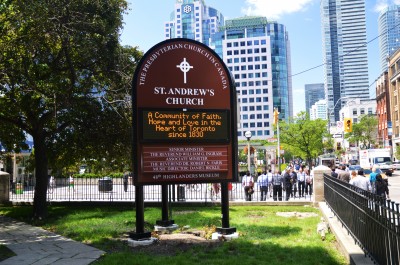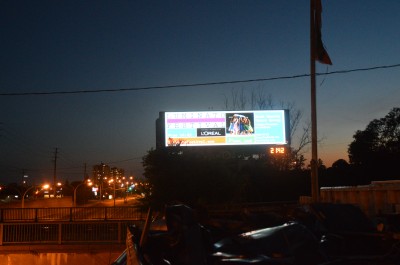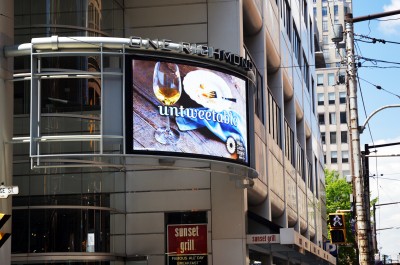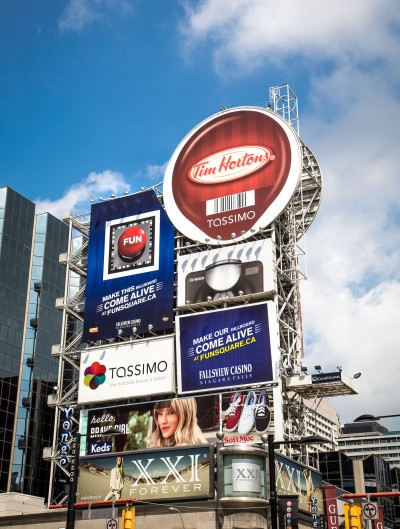Reviewing Toronto’s regulations
by all | 21 January 2014 8:30 am
 [1]
[1]Photos courtesy Ted Van Vliet
By Peter Saunders
Toronto’s sign bylaw unit is currently reviewing its municipal regulations, particularly those relating to electronic message centres (EMCs) and other forms of outdoor illuminated and digital signs and billboards. This process has involved collecting public and industry input with regard to potential bylaw changes for both first-party and third-party signage, as well as traffic safety implications.
The following are some of the specific issues being considered as part of this review:
- Locations where illuminated and electronic signs should be allowed in the city.
- The effect of these signs on surrounding neighbourhoods.
- The effect of these signs on public spaces.
All Toronto residents and businesses have been encouraged to participate in the process and provide feedback about these important issues.
The need for a new review
In July 2012, city council directed the sign bylaw unit to undertake a major review, including a study of the impact of electronic signs, and report back within two years (i.e. by July 2014).
At the time, there were many site-specific applications for sign variances across Toronto, i.e. to permit signs not covered by existing regulations. The sign bylaw included a process for considering these site-by-site regulatory amendments, but if municipal policy were to be created solely on such a basis, there would be no comprehensive regulations. So, as the volume of these applications rose above anticipated levels, with a trend toward the installation of more electronic signs, the need for a new review became apparent.
 [2]
[2]Many churches, schools and community centres integrate ‘readograph’ EMCs into larger sign structures. This has raised the issue of illumination guidelines in residential areas.
The bylaw was previously revised in 2008 and 2009 and a new version passed in 2010, reflecting an effort to harmonize various rules in the wake of the 1998 amalgamation of six former municipalities (Old Toronto, York, Etobicoke, North York, East York and Scarborough). Regulatory exceptions were made for ‘special sign districts,’ including Chinatown and Yonge-Dundas Square, which are known for particularly large and bright signage, and a distinction was made between residential and commercial zones. Illuminated signs were widely permitted, while electronic signs were not.
Since then, other Canadian jurisdictions have introduced new regulations with respect to electronic signs.
In February 2013, Toronto’s planning and growth management committee asked staff to report specifically about the effects of illuminated signs in residential areas and to make recommendations accordingly. This was due to demand for illuminated signs among schools, churches and other organizations operating within residential neighbourhoods.
The current study has comprised three parts:
- Planning and design review.
- Public opinion poll.
- Transportation safety review.
Planning and design review
Toronto’s planning and design review identified a number of potential ‘impacts’ of illuminated and electronic signs, including inconsistent or excessive brightness, light spilling onto adjacent properties, signs illuminated at undesirable times, disturbing electronic transition effects and public safety concerns relating to driver and pedestrian distraction. There was also a concern that many signs are not designed to fit with local architecture or to accommodate other urban design considerations.
 [3]
[3]Toronto’s sign bylaw includes controls for the brightness of digital billboards.
The review considered performance standards for electronic signs in other jurisdictions across North America.
Public opinion poll
Toronto’s sign bylaw unit commissioned Ipsos Reid to conduct research among the public to better understand attitudes, opinions and behaviours associated with electronic and illuminated signs around the city. A representative sample of more than 1,500 Toronto residents over the age of 18 were surveyed online from July 5 to 18, 2013.
The survey found the vast majority (70 per cent) of residents believed these types of signs are a normal part of public spaces in big cities like Toronto; 55 per cent said they contribute to the look and vibrancy of cities; and 48 per cent said they are an attractive element of Toronto’s cityscape (while only 25 per cent disagreed).
That said, when asked whether or not they were concerned about the negative impacts of signs on the look of their neighbourhood or their enjoyment of their home, Torontonians were generally split, with about one-third agreeing, one-third disagreeing and one-third in the middle. Those living downtown or in north Scarborough tended to be more concerned than others.
While 63 per cent of Torontonians said electronic and illuminated signs are useful to them, it is worth noting 55 per cent said the city needs to do more to control their use. Most respondents did not have an issue with when the signs are illuminated, nor with how many are installed across the city.
Overall, the poll indicated people were agreeable to electronic signs in commercial and industrial areas, but not in residential neighbourhoods.
Transportation safety review
In response to some of the aforementioned concerns, a transportation safety study was undertaken, based on existing literature—including Safety Impacts of the Emerging Digital Display Technology for Outdoor Advertising Signs, published in 2009—and a statistical analysis of traffic along Toronto’s Gardiner Expressway, which is flanked by many billboards, including some digital ones. (Specifically, the stretch of the expressway between Dufferin Street and Strachan Avenue, referred to by the city as the ‘Gardiner Gateway,’ has been designated a special sign district.)
Conducted by Cima+, an engineering company, the analysis focused on areas between signs and the points from which they are visible to drivers. The study found no statistically significant increase in collisions or other traffic incidents near the signs, although it did determine electronic signs can be more distracting than other signs.
This finding was supported by the public opinion survey. When Ipsos Reid asked Toronto drivers about sources of distraction, 52 per cent said electronic or illuminated signs are distracting—roughly on par with Global Positioning System (GPS) and road-map displays—compared to only 18 per cent finding ‘traditional’ non-electric signs distracting.
Studying sign types
The following are the sign types included in the current study:
Illuminated signs
The majority of third-party signs in Toronto are illuminated, whether they are used for advertising, direction or identification. They are permitted throughout the city and often located close to residential or open-space land use.
The sign bylaw incorporates requirements with regard to brightness levels at different times of day.
Readograph signs
Whether they are EMCs or physical letter inserts on a board, readograph signs are commonly integrated into larger sign structures. They are often used for such institutions as schools, churches and community centres.
Toronto’s sign bylaw restricts them to displaying only alphanumeric copy, i.e. no images, and they are generally limited to 50 per cent of the total sign face area. As with illuminated signs, there are controls over EMC brightness, hours of operation and message transitions and dwell time.
 [4]
[4]Outdoor digital signs displaying full-motion content are approved only by special variance or bylaw amendment.
‘Static’ digital signs
There is high demand for ‘static’ digital signage, which rotates through changeable messages without motion. These signs are often found as stand-alone billboards, but can also be integrated into structures.
Toronto’s sign bylaw restricts this type to two areas of the city—i.e. the Yonge-Dundas Square and Gardiner Gateway special sign districts—with controls on brightness, message transitions (one second, no effects), dwell time (10 seconds) and hours of operation.
‘Moving’ digital signs
There is less demand for full-motion third-party outdoor digital signs, which in Toronto are limited by the sign bylaw to the Yonge-Dundas Square special sign district (although variances have resulted in some being installed elsewhere). Like static digital signs, they can be stand-alone models or integrated with other signs. The sign bylaw controls their brightness and hours of operation.
Projected digital signage
Digital projections are used in Toronto at night for advertising, art installations (often incorporating sponsorship messages) and special events. They are not currently permitted under the sign bylaw, as they often involve multiple properties and would be complicated to deal with in a bylaw. They are considered signs, but do not have any structure associated with them.
Future directions
Based on findings from the new study, a consultant retained by Toronto’s sign bylaw unit has proposed the following policy directions:
General requirements
- Reduce maximum illumination levels to 300 nits from sunset to sunrise and 3,000 nits from sunrise to sunset.
- Reduce the maximum level of light trespass from 6.5 lux above ambient light levels to 3 lux when measured from a distance of 10 m (32.8 ft).
Illuminated signs in residential districts
- Continue to permit illuminated signs in residential districts only for institutional uses, such as schools and churches.
- Reduce period of illumination in residential districts to 7 a.m. to 9 p.m., while maintaining current hours of 7 a.m. to 11 p.m. in other sign districts.
Readograph signs
- Permit readograph sign copy for institutional uses in residential districts, subject to: minimum message duration of 60 minutes; maximum transition of one second; no visible transition effects, such as motion, fading or flashing; and the aforementioned reduced hours of illumination.
- Maintain readograph sign copy rules for all other sign districts.
 [5]
[5]Several years ago, Toronto’s Yonge-Dundas Square was designated a ‘special sign district,’ as it is known for particularly large and bright signage. File photo
Static digital signs
- Permit third-party static digital signs in commercial and ‘employment’ districts, subject to: minimum 60-m (197-ft) setbacks from intersections and residential or residential/commercial districts; minimum 150-m (492-ft) setbacks from other third-party non-digital signs; minimum 500-m (1,640-ft) setbacks from other third-party digital signs; and the application of all other current regulations for these types of signs.
- For first-party signs, allow up to 30 per cent of a wall sign and 50 per cent of a ground sign to consist of digital static copy in commercial and employment districts, with minimum 60-m (197-ft) setbacks from intersections and residential or residential/commercial districts and minimum 300-m (984-ft) distances from other signs displaying digital static copy. These would be subject to a minimum message duration of 60 minutes, maximum one-second transitions and no visible transition effects (e.g. motion, fading, flashing).
Moving digital signs
- Maintain current provisions for signs displaying dynamic digital copy, with approval only by sign variance or bylaw amendment.
Projected digital signage
- Maintain current provisions for projected images, with approval only by sign variance or bylaw amendment.
- Allow temporary approvals for special events through Toronto’s economic development, culture and tourism office.
The next steps will be to review information from public and stakeholder consultations, review applicable regulations and prepare a set of final recommendations for city council. Data and comments from consultations will be collated and legal issues will be analyzed.
One of the challenges is Toronto has a lot of mixed-use space, where the lines between residential and commercial districts are blurring, and there is a lot of planned residential use of what were previously industrial or commercial parts of the city. Broader consultation will help make any new bylaw more legally defensible.
Overall, there is more comfort with digital signage today than during the last bylaw review in 2008 and 2009. Back then, many people were afraid there would be giant TVs, but those fears have not come to pass—and ‘giant TV’ has not generally been the industry’s business model anyway.
With files from Ted Van Vliet, manager of Toronto’s sign bylaw unit, who presented a seminar about Toronto’s EMC-related regulations at the Sign Association of Canada’s (SAC’s) 2013 CONSAC trade show and conference. For more information, contact him via e-mail at tvanvli@toronto.ca[6].
- [Image]: http://www.signmedia.ca/wp-content/uploads/2014/01/DSC_0112.jpg
- [Image]: http://www.signmedia.ca/wp-content/uploads/2014/01/DSC_0088.jpg
- [Image]: http://www.signmedia.ca/wp-content/uploads/2014/01/DSC_0134.jpg
- [Image]: http://www.signmedia.ca/wp-content/uploads/2014/01/DSC_0072.jpg
- [Image]: http://www.signmedia.ca/wp-content/uploads/2014/01/R5A7598_web_crop.jpg
- tvanvli@toronto.ca: mailto:tvanvli@toronto.ca
Source URL: https://www.signmedia.ca/reviewing-torontos-regulations/